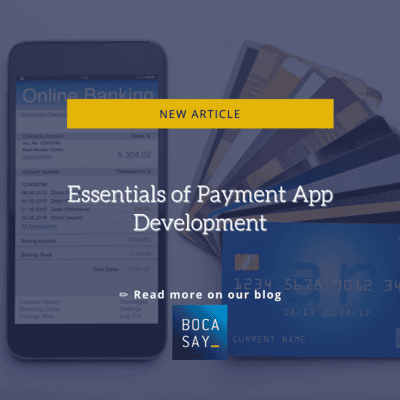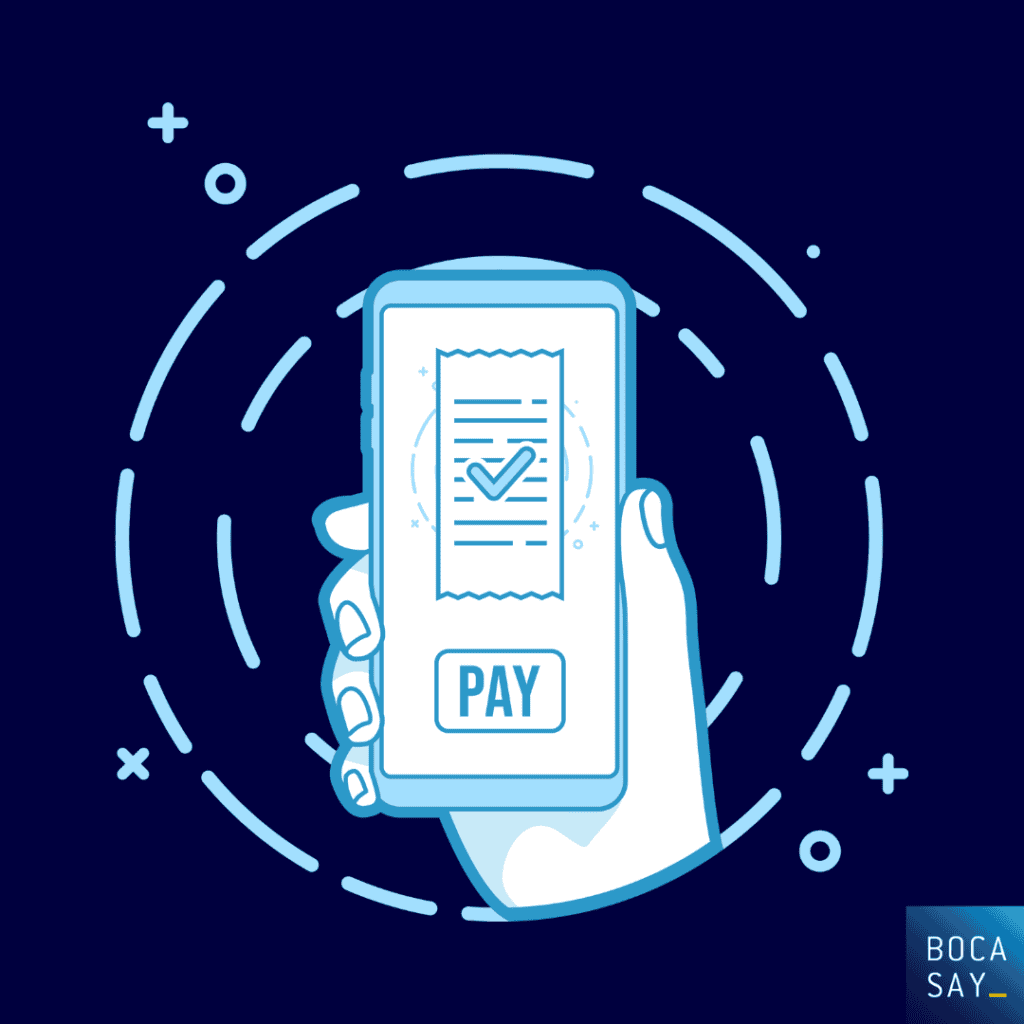Essentials of Payment App Development
The fintech industry is booming, and as various market landscapes evolve faster than ever before, secure digital payments remain at the forefront of successful e-commerce.
Custom payment apps are leading the way and there are some encouraging numbers too: for example, by 2026, the US mobile wallet market is projected to reach $80 billion.
Do you need a money transfer application for your online business? In this article, Bocasay, our offshore outsourcing company, provides an overview of the essential practices of payment app development.

What is a P2P Payment System?
A peer-to-peer payment system, or a money transfer app, is a software application that enables its users to transfer funds from one application user to another. These days, payment apps can be used for just about any type of transaction: to pay for a taxi, perform an international money transfer, or even to split a restaurant bill with your friends.
Even though there are different types of payment apps, all varying in functionality, they are all based on a similar design logic. Most often, a payment app user needs to create a new account, verify their real identity and then link a bank account or card to their payment application account. After that, most payment apps will only require a few clicks in order to complete a money transfer.
In general, payment apps can perform the following tasks:
⇢ Complete multiple-currency transactions internationally.
⇢ Provide a multi-lingual transaction user-interface.
⇢ Tracking and monitoring of money transfers and transaction fees.
⇢ Requesting payments directly from client and project collaborators.
⇢ Automatically sharing payments between multiple parties involved.
Types of P2P Payment Applications
Standalone Payment App
These are independent apps that more or less free their users from the complexities of banking infrastructure. Users usually deposit funds directly from their bank account into the app’s e-wallet, and that allows them to transfer money to anyone using the same app.
Bank-Centric Payment App
It’s no surprise that traditional mainstream banks would also develop their very own P2P payment apps, in order to enhance and optimize their existing banking infrastructure. They allow users to perform cashless payments and to monitor the status of their bank accounts through a smartphone.
Social Media-Based Payment App
Always promoting seamless user-interaction, various popular social media and messaging services -like Facebook and WhatsApp- enable their users in certain countries to perform money transactions without leaving the main app interface.
Mobile OS Payment App
Usually refers to a digital wallet service that is specifically built upon a mobile device operating system. Popular examples include Android Pay, Samsung Pay and Apple Pay. These apps offer their users QR code-enabled offline payments, as well as seamless online payment services.
Foreign Exchange Payment App
As the name implies, these types of apps enable their users to perform money transactions in multiple currencies. They are often preferable to traditional banking services because they can offer lower currency exchange fees than most mainstream banks.
𝔸𝕣𝕖 𝕪𝕠𝕦 𝕝𝕠𝕠𝕜𝕚𝕟𝕘 𝕗𝕠𝕣 𝕒𝕟 𝕀𝕋 𝕡𝕒𝕣𝕥𝕟𝕖𝕣 𝕥𝕠 𝕕𝕖𝕧𝕖𝕝𝕠𝕡 𝕒 𝕔𝕦𝕤𝕥𝕠𝕞 𝕒𝕡𝕡𝕝𝕚𝕔𝕒𝕥𝕚𝕠𝕟? 𝕀𝕥’𝕤 𝕧𝕖𝕣𝕪 𝕤𝕚𝕞𝕡𝕝𝕖, 𝕛𝕦𝕤𝕥 𝕔𝕠𝕟𝕥𝕒𝕔𝕥 𝕥𝕙𝕖 𝕠𝕗𝕗𝕤𝕙𝕠𝕣𝕖 𝕠𝕦𝕥𝕤𝕠𝕦𝕣𝕔𝕚𝕟𝕘 𝕔𝕠𝕞𝕡𝕒𝕟𝕪 𝔹𝕠𝕔𝕒𝕤𝕒𝕪 𝕥𝕠 𝕘𝕖𝕥 𝕒 𝕗𝕣𝕖𝕖 𝕢𝕦𝕠𝕥𝕖!
Top Features for Payment Apps
Funds Exchange
As long as a user has available funds in their app e-wallet, then they can transfer that amount to their chosen recipient and they can also receive funds from other apps users.
Smart Analytics
Encouraging responsible spending practices, payment apps allow users to review expenses over specific time periods, to plan their future spending, as well to set-up saving goals.
Multi-Factor Authentication
One-time-passwords, PIN numbers and biometric data are deployed by payment app developers in order to prevent access by unauthorized users or hackers. These practices also ensure that a user cannot accidentally transfer funds.
Banking-Compatible
Apart from allowing payment app users to transfer funds to other users of the same app, payment app developers have also introduced the capability of transferring funds directly into mainstream bank-accounts.
Customer Support
When payment app users face any technical or transactional issues while using the app, the interface will often provide a helpful AI chatbot that can instantly solve issues and answer the most frequently asked questions.

Key Stages of Payment App Development
1. Market Research
Much like launching any other product or service, before developing a payment app, you need to conduct meticulous market and technical research in order to find out if there is any actual demand for what you are considering to offer.
Study the digital payment industry, check-out exactly what your competitors are doing and ultimately determine exactly how your payment app will add value to an already highly-competitive payment app market.
2. App Type
Choose the type of payment app you would like to develop according to your business values, particular goals and market sector you would like to operate in.
For example, will most of your clients be happy with you integrating a standalone app like Paypal into your platform? Or would they prefer a dedicated seamless payment app that is fully integrated with various other services your platform offers?
3. Audience Testing
Launching a new app will always involve some risk. However, you can reduce this risk by carefully studying the habits and desires of your intended audience, or clients. Conduct feasibility studies, interviews, focus groups, surveys, and anything else that enables you to understand how to build an app that will offer real user value.
4. Design
Following your market research and audience studies, the design stage begins by structuring your feasibility data into mind maps that provide a visual overview of the intended application.
This is the stage in which developers will follow specifications in order to design the app’s UX and UI, optimizing user interaction and aligning the whole process with your particular business goals.
5. Minimum Viable Product (MVP)
Before launching your new payment app, it is important to first test the market with an MVP. This stage involves developers fixing coding bugs, fine-tuning technology integrations, and basically testing the app’s user functionality. It also often involves a limited number of actual end-users who test the MVP and provide developers with valuable feedback that helps to ensure that the app is as functional as possible.
6. Launch and Maintenance
Once launching your new payment app, developers have to continue optimizing all aspects of the app’s operation and functionality.
This involves monitoring user feedback and analytics in order to identify bugs and their speedy fixes, as well as developing new features according to market demands and dynamics.